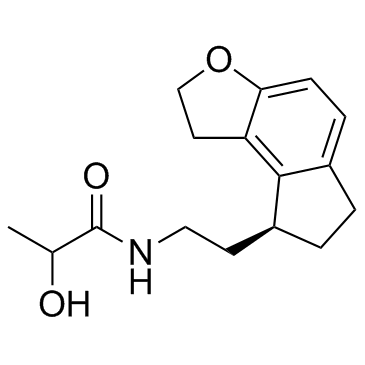896736-21-3
| Name | 2-hydroxy-N-[2-[(8S)-2,6,7,8-tetrahydro-1H-cyclopenta[e][1]benzofuran-8-yl]ethyl]propanamide |
|---|---|
| Synonyms |
2-Hydroxy-N-[2-[(8S)-1,6,7,8-tetrahydro-2H-cyclopenta[e]benzofuran-8-yl]ethyl]-propanamide
Propanamide,2-hydroxy-N-[2-[(8S)-1,6,7,8-tetrahydro-2H-indeno[5,4-b]furan-8-yl]ethyl] Ramelteon Metabolite M-II (mixture of R and S at the hydroxy position) Ramelteon Metabolite M-II |
| Description | Ramelteon metabolite M-II is the major metabolite of Ramelteon, with IC50s of 208 pM, 1470 pM for human melatonin receptors (MT1 or MT2). Ramelteon is a selective melatonin agonist. |
|---|---|
| Related Catalog | |
| In Vitro | The affinity of Ramelteon metabolite M-II (M-II) for MT1 receptors is 10- and 2.5-fold lower than that of ramelteon and melatonin, respectively. Likewise, the affinity of M-II for MT2 receptors is approximately 5- and 1.5-fold lower than that of ramelteon and melatonin, respectively. Ramelteon metabolite M-II exhibits no affinity for quinone reductase 2 at concentrations up to 10 μM. Moreover, the selectivity of Ramelteon metabolite M-II for melatonin receptors relative to 215 targets including other receptors, transporters, ion channels and enzymes is investigated. Ramelteon metabolite M-II shows no significant affinities and activities for the other targets, except for the 5-HT2B receptor, for which the Ki value was 1.75±0.23 μM. The potency of Ramelteon metabolite M-II for MT1 receptors is approximately 17- and 4.3-fold lower than that of ramelteon and melatonin, respectively. Similarly, the potency of Ramelteon metabolite M-II for MT2 receptors is approximately 28- and 1.6-fold lower than that of ramelteon and melatonin, respectively[1]. |
| In Vivo | Ramelteon metabolite M-II (1 mg/kg) significantly increases NREM sleep (F1,7=96.3, p<0.01) and significantly decreases wakefulness (F1,7=56.7, p<0.01). Moreover, a lower dose of M-II (0.1 mg/kg) yield similar results (NREM, F1,7=121.9, p<0.01; wakefulness, F1,7=87.0, p<0.01), and decreased wakefulness is sustained for 6 h after the administration of either dose. After the administration of 0.01 mg/kg Ramelteon metabolite M-II, only NREM sleep is significantly increased (F1,7=10.5, p< 0.05). No significant differences in REM sleep are observed after the administration of M-II at any of the doses tested in this study[1]. |
| Animal Admin | Cats[1] Eight adult cats weighing 2.4-5.9 kg are used in each study. The cats are housed individually in rooms maintained at 22-26 °C with a 12-h light-dark cycle (lights on at 7.00 a.m.), fed once daily (9.00 a.m.) and given water ad libitum. The cats are anesthetized, and electrodes are surgically implanted for electroencephalogram (EEG), electromyogram (EMG) and electrooculogram (EOG) monitoring. After a recovery period of at least 7 days, the cats are well accustomed to the test chamber (65×35×45 cm). Ramelteon metabolite M-II is orally administered at 0.1 mL/kg to each cat using gelatin capsules. The effects of M-II on sleep are compared with those of the vehicle using a crossover design. The interval between trials is >6 days. The cats are given Ramelteon metabolite M-II (0.001, 0.01, 0.1 or 1 mg/kg) or vehicle between 9.55 and 10.00 a.m. Immediately after the administration, EEG, EOG and EMG recordings are started sequentially and lasted 8 h. The durations of sleep stages are measured after the administration of vehicle or M-II and are presented as mean percentages of time spent in each stage at each 2-hour period after administration[1]. |
| References |
| Density | 1.199g/cm3 |
|---|---|
| Boiling Point | 495.171ºC at 760 mmHg |
| Melting Point | 96-98ºC |
| Molecular Formula | C16H21NO3 |
| Molecular Weight | 275.34300 |
| Flash Point | 253.271ºC |
| Exact Mass | 275.15200 |
| PSA | 58.56000 |
| LogP | 1.92930 |
| Index of Refraction | 1.576 |
